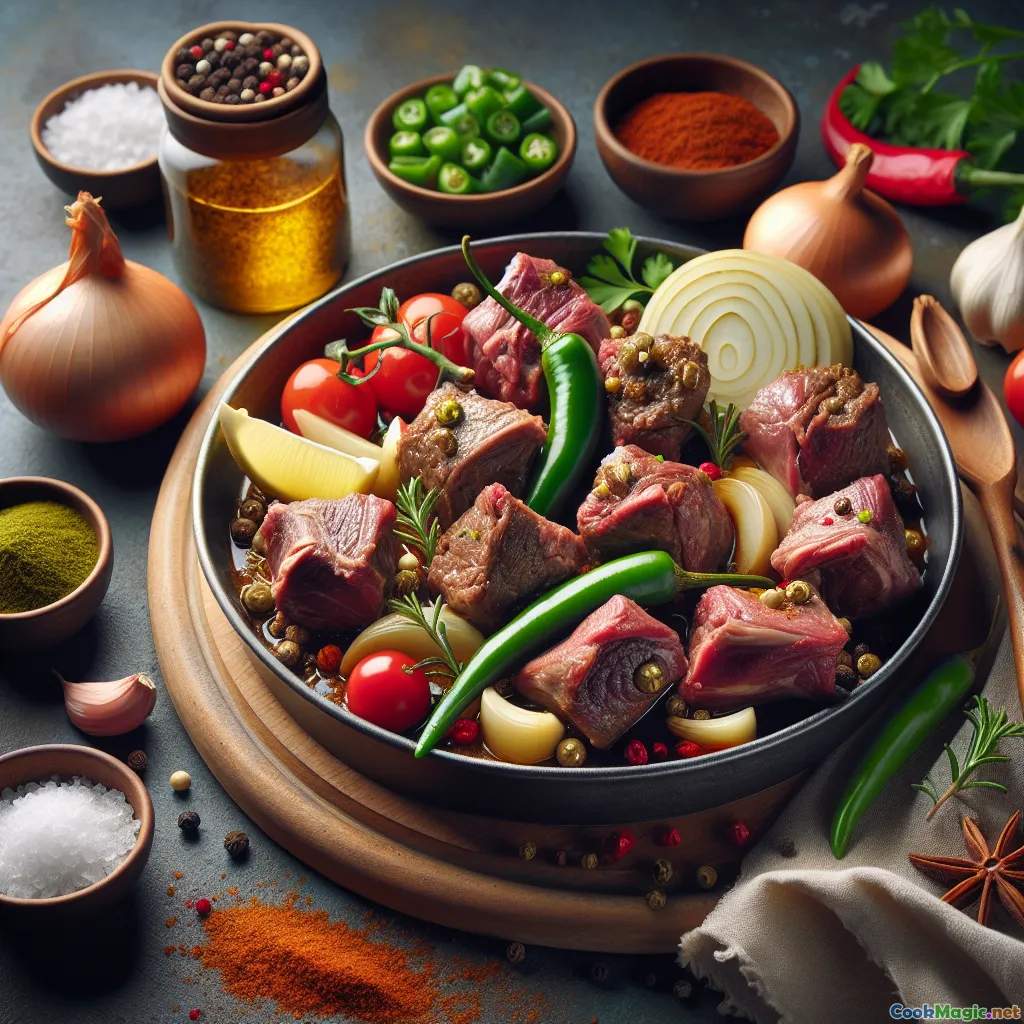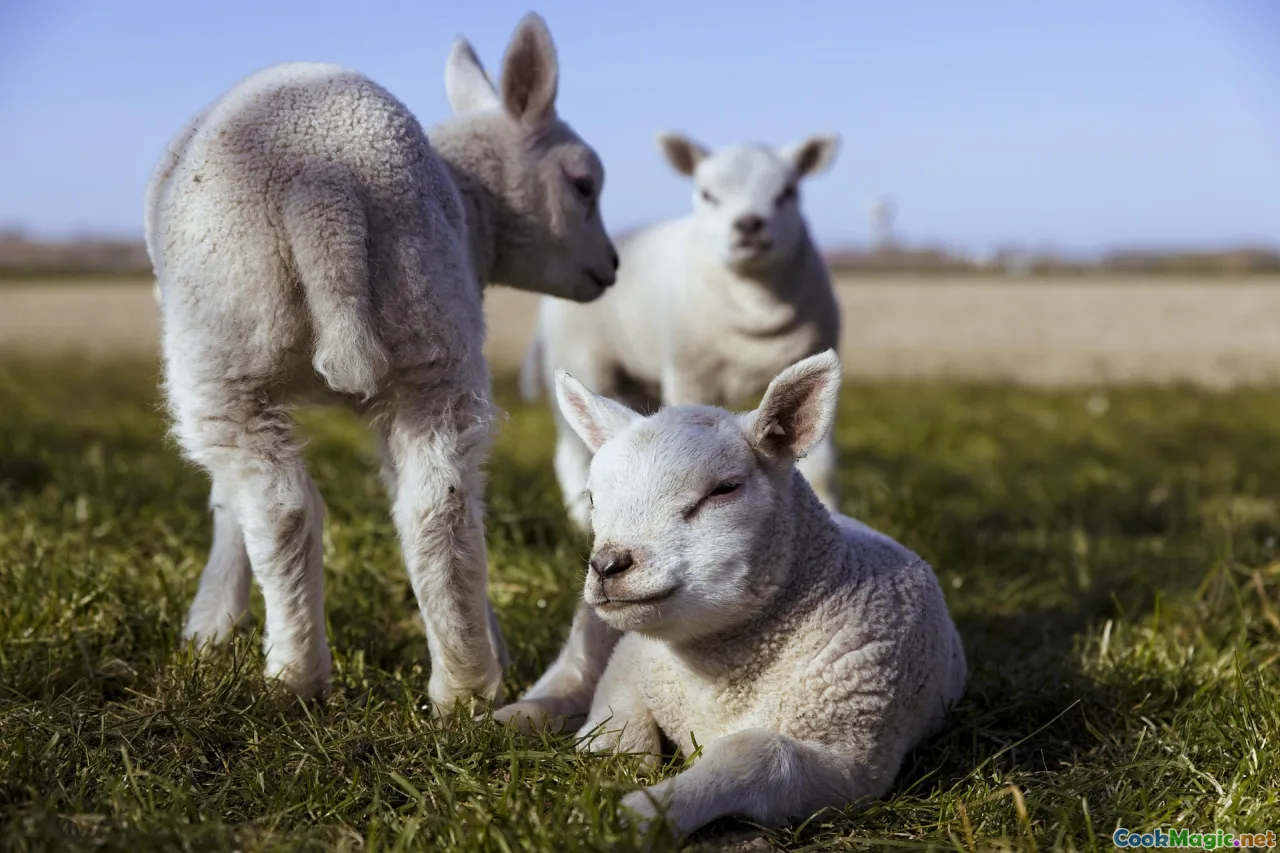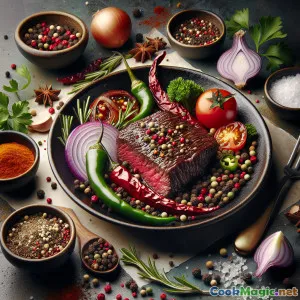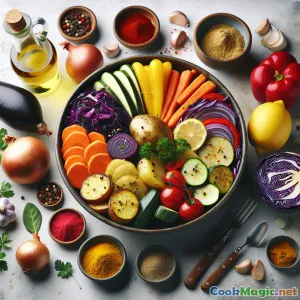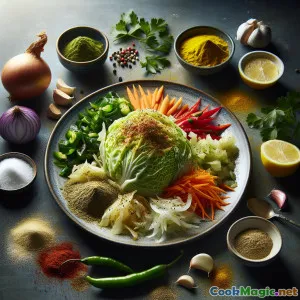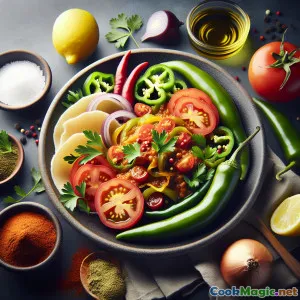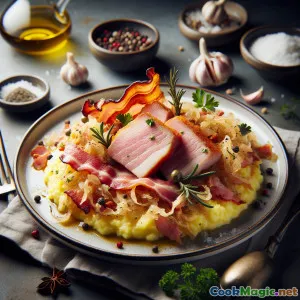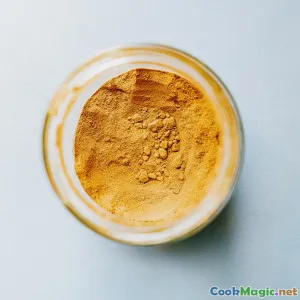
泰杰调味羊肉蒂布西:独特的埃塞俄比亚炒菜
(Tej-Infused Lamb Tibsi: A Unique Ethiopian Sauté)
(0 评论)食材
-
500 grams 去骨羊腿肉,切块
(切成1厘米见方的小块)
-
3 tbsp 尼特尔基贝(埃塞俄比亚香料酥油)
(自制或商店购买;用无盐黄油混合少许豆蔻、葫芦巴籽、大蒜和姜来替代)
-
1.5 tbsp 贝尔贝雷香料混合
(调回至1汤匙,保持中火。)
-
1 large 黄洋葱,细切
(大约200克)
-
3 cloves 大蒜瓣,切碎
-
2 medium 熟番茄,切碎
(总计约180克)
-
1 medium 墨西哥辣椒或埃塞俄比亚辣椒,切片
(用塞拉诺辣椒替代以做出更辣的菜肴)
-
125 ml Tej(衣索比亞蜂蜜酒)
(或者将1汤匙蜂蜜拌入干白葡萄酒。)
-
2 tsp 新鲜迷迭香,切碎
-
2 tbsp 新鲜切碎的欧芹
-
1 tsp 盐
(按个人口味)
-
0.5 tsp 现磨黑胡椒
-
4 slices 柠檬楔
(用于上菜)
(切成1厘米见方的小块)
(自制或商店购买;用无盐黄油混合少许豆蔻、葫芦巴籽、大蒜和姜来替代)
(调回至1汤匙,保持中火。)
(大约200克)
(总计约180克)
(用塞拉诺辣椒替代以做出更辣的菜肴)
(或者将1汤匙蜂蜜拌入干白葡萄酒。)
(按个人口味)
(用于上菜)
营养
- 份量: 4
- 每份大小: 1盘(250克)
- Calories: 550 kcal
- Carbohydrates: 19 g
- Protein: 40 g
- Fat: 32 g
- Fiber: 4 g
- Sugar: 8 g
- Sodium: 770 mg
- Cholesterol: 120 mg
- Calcium: 48 mg
- Iron: 5 mg
制作步骤
-
1 - 准备食材:
把羊肉切成一口大小的方块。把洋葱切成丁,番茄切成丁,大蒜切成末,辣椒切成薄片。准备并量好所有香草和香料。
-
2 - 煎羊肉:
在一个大号厚底平底锅或铸铁锅中,用中高火加热2汤匙的niter kibbeh。加入切成方块的羊肉;将其煎至四面略呈棕色。取出并留待备用。
-
3 - 翻炒香料:
把火调小到中火。加入剩余的 niter kibbeh,其后加入洋葱。翻炒 3-4 分钟,直到洋葱变透明。加入大蒜和辣椒;再煮 1 分钟。
-
4 - 调制酱汁:
将 Berbere 香料煸香以释放香气,然后加入切碎的番茄。边煮边搅拌4-5分钟,直到番茄变软,酱汁变稠。
-
5 - 用 Tej 去锅底:
加入 tej,用铲子刮起锅底的棕色焦碎。让酱汁小泡2分钟,以去除锅底残渣并让酒精蒸发。
-
6 - 把羊肉放回锅中,小火慢炖。:
将羊肉与迷迭香、盐和胡椒一起放回平底锅。调小火,盖上锅盖,小火慢炖12–15分钟,偶尔搅拌,直到羊肉刚好变软、酱汁粘稠。
-
7 - 完成与装饰:
品尝并调味。离火后,撒上新鲜的欧芹,并配上柠檬角。搭配因杰拉面包或米饭。
把羊肉切成一口大小的方块。把洋葱切成丁,番茄切成丁,大蒜切成末,辣椒切成薄片。准备并量好所有香草和香料。
在一个大号厚底平底锅或铸铁锅中,用中高火加热2汤匙的niter kibbeh。加入切成方块的羊肉;将其煎至四面略呈棕色。取出并留待备用。
把火调小到中火。加入剩余的 niter kibbeh,其后加入洋葱。翻炒 3-4 分钟,直到洋葱变透明。加入大蒜和辣椒;再煮 1 分钟。
将 Berbere 香料煸香以释放香气,然后加入切碎的番茄。边煮边搅拌4-5分钟,直到番茄变软,酱汁变稠。
加入 tej,用铲子刮起锅底的棕色焦碎。让酱汁小泡2分钟,以去除锅底残渣并让酒精蒸发。
将羊肉与迷迭香、盐和胡椒一起放回平底锅。调小火,盖上锅盖,小火慢炖12–15分钟,偶尔搅拌,直到羊肉刚好变软、酱汁粘稠。
品尝并调味。离火后,撒上新鲜的欧芹,并配上柠檬角。搭配因杰拉面包或米饭。
关于 泰杰调味羊肉蒂布西:独特的埃塞俄比亚炒菜 :的更多信息
Tej Infused Lamb Tibsi: Fusion and Flavor in Every Bite
Tej Infused Lamb Tibsi is a distinctively creative take on the classic Ethiopian Tibsi, a beloved skillet-cooked meat dish typically shared during social gatherings, feasts, or celebratory moments. By artfully integrating tej — a traditional Ethiopian honey wine — this recipe pays homage to centuries of East African food culture while infusing new dimensions of aroma, body, and complexity into every forkful.
The Essence of Tibsi
At its core, tibsi refers to meats sautéed with onions, peppers, and berbere (Ethiopia’s iconic chili and spice blend), often finished with fragrant spiced clarified butter known as niter kibbeh. This method yields rich, layered results perfectly paired with injera (the characteristic sourdough flatbread) or fluffy white rice.
Tej: An Ancestral Elixir
Tej is no ordinary addition. Made from fermented honey, water, and occasionally gesho leaves (similar to hops), tej’s sweet-floral bright notes play a transformative role in both sacred feasts and lively communal meals throughout Ethiopia. Tej not only contributes light caramel undertones and subtle alcoholic zing but also connects modern kitchens to a timeless artisanal beverage.
While tej can be enjoyed by the glass on its own, here it doubles as a deglazing liquid — coaxing sticky browned starch from the bottom of your skillet and infusing the lamb tibsi with mellow overtones. If sourcing tej presents a hurdle, a blend of dry white wine and honey gives comparable results with extra floral depth.
Cooking Tips and Notes
- Niter Kibbeh: This is a backbone of Ethiopian cuisine, joyfully nutty with its slow-cooked butter, cardamom, fenugreek, and sometimes bishop’s weed (ajwain seeds). While dedicated Ethiopian spice shops may carry it, making your own delivers incredible aromatic distinction.
- Lamb Selection: Opt for boneless leg — tender and flavorful yet sturdy enough for skillet frying. Shoulder works, too, with small adjustments in cook time.
- Berbere Variability: Berbere spice’s composition can range in heat and complexity — tweak the quantity to suit your guests’ palate. Mild for sharing, spicier for lovers of authentic African heat!
- Pan Matters: A sturdy, heavy-bottomed or cast iron skillet encourages a deep, flavor-rich fond, vital for integrating all elements when deglazing with tej.
- Garnish with Generosity: Parsley offers invigorating freshness; thin jalapeño slices pack heat and contrast. Lemon is not strictly traditional but brightens and balances the luxuriously spiced lamb.
Cultural and Personal Significance
Tibsi sits at a cultural crossroads: celebratory yet accessible, festive yet everyday. By including tej, this dish—a standard for many Ethiopian homes—expands its flavor roster in honor of both heritage and culinary creativity. Meals like this bring people together, often eaten communally from a shared platter atop clouds of injera. Even in modern kitchens across the world, reliving this experience (and experimenting with pairings like quinoa or couscous) bridges continents and generations alike.
For me, preparing Tej Infused Lamb Tibsi means blending bold spices, sweet-warm honey notes, and carefully developed textures. It embodies balance: fiery heat balanced by aromatic butter and mild sweetness, simple technique offset by complex flavors. Serve this to adventurous guests — the fragrance alone will win them, the memory will keep them coming back.
Unique Aspects
- The use of tej in savory cookery is rare even in Ethiopia; here, it showcases the beverage’s versatility.
- This fusion respects traditional preparation but also modernizes with accessible adaptations depending on ingredients available globally (like substituting dry wine and honey for tej).
- Its nutritional value, balancing protein, healthy fats, and spice-driven antioxidants, makes it both satisfying and nourishing.
- Perfect for sharing at festive tables where great food walks hand-in-hand with storytelling and new friendship.
Give Tej Infused Lamb Tibsi pride of place at your table — its warmth and character tell a story centuries in the making, yet as vibrant and contemporary as today’s brightest kitchens!
